Rape Straw Supported FeS Nanoparticles with Encapsulated Structure as Peroxymonosulfate and Hydrogen Peroxide Activators for Enhanced Oxytetracycline Degradation
Abstract
1. Introduction
2. Materials and Methods
2.1. Samples and Reagents
2.2. Preparation of the Catalysts
2.3. The Characterization of Catalysts
2.4. Batch Experiments
2.4.1. OTC Removal Comparison Experiments in Different Systems
2.4.2. Single Factor Experiments
2.4.3. Cycling Experiments
2.4.4. Treatment of Actual Wastewater
3. Results and Discussion
3.1. Characterization of RS–FeS and RS–EDTA–FeS
3.2. Degradation of OTC in Different Systems
3.3. Effects of Solution Chemistry on OTC Degradation by RS–FeS and RS–EDTA–FeS
3.3.1. Solution pH
3.3.2. OTC Concentration
3.3.3. PMS Concentration
3.3.4. H2O2 Dosage
3.3.5. Coexisting Substances
3.4. Identify the Active Species and Reaction Mechanism
3.5. Reusability of RS–FeS and RS–EDTA–FeS
3.6. Practical Application and Cost Estimation
4. Conclusions
Supplementary Materials
Author Contributions
Funding
Institutional Review Board Statement
Informed Consent Statement
Data Availability Statement
Conflicts of Interest
Sample Availability
References
- Cheng, W.; Li, J.; Wu, Y.; Xu, L.; Su, C.; Qian, Y.; Zhu, Y.; Chen, H. Behavior of antibiotics and antibiotic resistance genes in eco-agricultural system: A case study. J. Hazard. Mater. 2016, 304, 18–25. [Google Scholar] [CrossRef] [PubMed]
- Wang, R.; Feng, F.; Chai, Y.; Meng, X.; Sui, Q.; Chen, M.; Wei, Y.; Qi, K. Screening and quantitation of residual antibiotics in two different swine wastewater treatment systems during warm and cold seasons. Sci. Total Environ. 2019, 660, 1542–1554. [Google Scholar] [CrossRef]
- Hong, P.; Wu, Z.; Yang, D.; Zhang, K.; He, J.; Li, Y.; Xie, C.; Yang, W.; Yang, Y.; Kong, L.; et al. Efficient generation of singlet oxygen (1O2) by hollow amorphous Co/C composites for selective degradation of oxytetracycline via fenton-like process. Chem. Eng. J. 2021, 421, 129594. [Google Scholar] [CrossRef]
- Nogueira-Lima, A.C.; Gesteira, T.C.V.; Mafezoli, J. Oxytetracycline residues in cultivated marine shrimp (Litopenaeus vannamei boone, 1931) (crustacea, decapoda) submitted to antibiotic treatment. Aquaculture 2006, 254, 748–757. [Google Scholar] [CrossRef]
- Thomas, N.; Dionysiou, D.D.; Pillai, S.C. Heterogeneous fenton catalysts: A review of recent advances. J. Hazard. Mater. 2021, 404, 124082. [Google Scholar] [CrossRef] [PubMed]
- Du, C.; Zhang, Y.; Zhang, Z.; Zhou, L.; Yu, G.; Wen, X.; Chi, T.; Wang, G.; Su, Y.; Deng, F.; et al. Fe-based metal organic frameworks (Fe-MOFs) for organic pollutants removal via photo-Fenton: A review. Chem. Eng. J. 2022, 431, 133932. [Google Scholar] [CrossRef]
- Chen, H.; Wang, J. MOF-derived Co3O4-C@FeOOH as an efficient catalyst for catalytic ozonation of norfloxacin. J. Hazard. Mater. 2021, 403, 123697. [Google Scholar] [CrossRef]
- Singh, S.; Kaur, P.; Abhivyakti; Kumar, V.; Tikoo, K.; Singhal, S. Facile integration of a novel Sm-doped CoFe2O4@ g-CN heterostructure to expedite PMS and H2O2 assisted degradation of pharmaceutical pollutants. Appl. Surf. Sci. 2022, 580, 152254. [Google Scholar] [CrossRef]
- Lai, X.; Ning, X.; Chen, J.; Li, Y.; Zhang, Y.; Yuan, Y. Comparison of the Fe2+/H2O2 and Fe2+/PMS systems in simulated sludge: Removal of pahs, migration of elements and formation of chlorination by-products. J. Hazard. Mater. 2020, 398, 122826. [Google Scholar] [CrossRef]
- Lee, Y.; Lee, S.; Cui, M.; Ren, Y.; Park, B.; Ma, J.; Han, Z.; Khim, J. Activation of peroxodisulfate and peroxymonosulfate by ultrasound with different frequencies: Impact on ibuprofen removal efficient, cost estimation and energy analysis. Chem. Eng. J. 2021, 413, 127487. [Google Scholar] [CrossRef]
- Huang, J.; Li, Z.; Zhang, J.; Zhang, Y.; Ge, Y.; Cui, X. In-situ synchronous carbonation and self-activation of biochar/geopolymer composite membrane: Enhanced catalyst for oxidative degradation of tetracycline in water. Chem. Eng. J. 2020, 397, 125528. [Google Scholar] [CrossRef]
- Chu, J.; Kang, J.; Park, S.; Lee, C. Enhanced sonocatalytic degradation of bisphenol a with a magnetically recoverable biochar composite using rice husk and rice bran as substrate. J. Environ. Chem. Eng. 2021, 9, 105284. [Google Scholar] [CrossRef]
- Qin, Y.; Li, X.; Wang, L.; Luo, J.; Li, Y.; Yao, C.; Xiao, Z.; Zhai, S.; An, Q. Valuable cobalt/biochar with enriched surface oxygen-containing groups prepared from bio-waste shrimp shell for efficient peroxymonosulfate activation. Sep. Purif. Technol. 2022, 281, 119901. [Google Scholar] [CrossRef]
- Gelardi, D.L.; Li, C.; Parikh, S.J. An emerging environmental concern: Biochar-induced dust emissions and their potentially toxic properties. Sci. Total Environ. 2019, 678, 813–820. [Google Scholar] [CrossRef]
- Oleszczuk, P.; Jośko, I.; Kuśmierz, M. Biochar properties regarding to contaminants content and ecotoxicological assessment. J. Hazard. Mater. 2013, 260, 375–382. [Google Scholar] [CrossRef]
- Yan, B.; Niu, C.H. Modeling and site energy distribution analysis of levofloxacin sorption by biosorbents. Chem. Eng. J. 2017, 307, 631–642. [Google Scholar] [CrossRef]
- Yin, Y.; Guo, X.; Peng, D. Iron and manganese oxides modified maize straw to remove tylosin from aqueous solutions. Chemosphere 2018, 205, 156–165. [Google Scholar] [CrossRef]
- Yu, H.; Wang, J.; Yu, J.; Wang, Y.; Chi, R. Adsorption performance and stability of the modified straws and their extracts of cellulose, lignin, and hemicellulose for Pb2+: pH effect. Arab. J. Chem. 2020, 13, 9019–9033. [Google Scholar] [CrossRef]
- Huang, H.; Ting, G.; Kai, W.; Yuan, L.; Gaoke, Z. Efficient activation of persulfate by a magnetic recyclable rape straw biochar catalyst for the degradation of tetracycline hydrochloride in water. Sci. Total Environ. 2021, 758, 143957. [Google Scholar] [CrossRef]
- Wu, S.; Yang, Y.; Deng, S.; Cao, H.; Liu, Y.; Yang, T.; Wu, D.; Wang, C.; Ma, Z. A novel preparation process of straw-based iron material for enhanced persulfate activation of reactive black 5 degradation. Environ. Sci. Pollut. Res. 2022, 29, 34174–34185. [Google Scholar] [CrossRef] [PubMed]
- Rubeena, K.K.; Hari Prasad Reddy, P.; Laiju, A.R.; Nidheesh, P.V. Iron impregnated biochars as heterogeneous fenton catalyst for the degradation of acid red 1 dye. J. Environ. Manag. 2018, 226, 320–328. [Google Scholar] [CrossRef] [PubMed]
- Yang, W.; Jing, L.; Wang, T.; Kong, X.; Quan, R.; Li, X.; Zhang, D.; Zhou, R.; Zhu, H. Multi-level porous layered biochar modified cobalt-iron composite as a reusable synergistic activator of peroxymonosulfate for enhanced tetracycline degradation. J. Taiwan Inst. Chem. Eng. 2022, 132, 104209. [Google Scholar] [CrossRef]
- Wang, S.; Wang, J. Magnetic 2D/2D oxygen doped g-C3N4/biochar composite to activate peroxymonosulfate for degradation of emerging organic pollutants. J. Hazard. Mater. 2022, 423, 127207. [Google Scholar] [CrossRef] [PubMed]
- Han, S.; Xiao, P. Catalytic degradation of tetracycline using peroxymonosulfate activated by cobalt and iron co-loaded pomelo peel biochar nanocomposite: Characterization, performance and reaction mechanism. Sep. Purif. Technol. 2022, 287, 120533. [Google Scholar] [CrossRef]
- Shin, J.; Bae, S.; Chon, K. Fenton oxidation of synthetic food dyes by Fe-embedded coffee biochar catalysts prepared at different pyrolysis temperatures: A mechanism study. Chem. Eng. J. 2021, 421, 129943. [Google Scholar] [CrossRef]
- Meng, H.; Nie, C.; Li, W.; Duan, X.; Lai, B.; Ao, Z.; Wang, S.; An, T. Insight into the effect of lignocellulosic biomass source on the performance of biochar as persulfate activator for aqueous organic pollutants remediation: Epicarp and mesocarp of citrus peels as examples. J. Hazard. Mater. 2020, 399, 123043. [Google Scholar] [CrossRef]
- Liang, F.; Liu, Z.; Jiang, X.; Li, J.; Xiao, K.; Xu, W.; Chen, X.; Liang, J.; Lin, Z.; Li, M.; et al. NaoH-modified biochar supported Fe/Mn bimetallic composites as efficient peroxymonosulfate activator for enhance tetracycline removal. Chem. Eng. J. 2023, 454, 139949. [Google Scholar] [CrossRef]
- Li, Z.; Wang, M.; Jin, C.; Kang, J.; Liu, J.; Yang, H.; Zhang, Y.; Pu, Q.; Zhao, Y.; You, M.; et al. Synthesis of novel Co3O4 hierarchical porous nanosheets via corn stem and MOF-Co templates for efficient oxytetracycline degradation by peroxymonosulfate activation. Chem. Eng. J. 2020, 392, 123789. [Google Scholar] [CrossRef]
- Wang, D.; Li, Y.; Wen, L.; Xi, J.; Liu, P.; Hansen, T.W.; Li, P. Ni-Pd-incorporated Fe3O4 yolk-shelled nanospheres as efficient magnetically recyclable catalysts for reduction of n-containing unsaturated compounds. Catalysts 2023, 13, 190. [Google Scholar] [CrossRef]
- Liangsong, W.; Dong, W.; Jiangbo, X.; Fan, T.; Pei, L.; Zheng-Wu, B. Heterometal modified Fe3O4 hollow nanospheres as efficient catalysts for organic transformations. J. Catal. 2022, 413, 779–785. [Google Scholar] [CrossRef]
- You, Y.; Shi, Z.; Li, Y.; Zhao, Z.; He, B.; Cheng, X. Magnetic cobalt ferrite biochar composite as peroxymonosulfate activator for removal of lomefloxacin hydrochloride. Sep. Purif. Technol. 2021, 272, 118889. [Google Scholar] [CrossRef]
- Wang, B.; Zhu, C.; Ai, D.; Fan, Z. Activation of persulfate by green nano-zero-valent iron-loaded biochar for the removal of p-nitrophenol: Performance, mechanism and variables effects. J. Hazard. Mater. 2021, 417, 126106. [Google Scholar] [CrossRef]
- Ali, M.; Danish, M.; Tariq, M.; Ahmad, A.; Shahzad Ayub, K.; Lyu, S. Mechanistic insights into the degradation of trichloroethylene by controlled release nano calcium peroxide activated by iron species coupled with nano iron sulfide. Chem. Eng. J. 2020, 399, 125754. [Google Scholar] [CrossRef]
- Hou, K.; Pi, Z.; Chen, F.; He, L.; Yao, F.; Chen, S.; Li, X.; Wang, D.; Dong, H.; Yang, Q. Peroxymonosulfate (PMS) activation by mackinawite for the degradation of organic pollutants: Underappreciated role of dissolved sulfur derivatives. Sci. Total Environ. 2022, 811, 151421. [Google Scholar] [CrossRef] [PubMed]
- Wu, L.; Guo, P.; Wang, X.; Li, H.; Zhang, X.; Chen, K.; Zhou, P. The synergy of sulfur vacancies and heterostructure on CoS@FeS nanosheets for boosting the peroxymonosulfate activation. Chem. Eng. J. 2022, 446, 136759. [Google Scholar] [CrossRef]
- Lyu, H.; Tang, J.; Huang, Y.; Gai, L.; Zeng, E.Y.; Liber, K.; Gong, Y. Removal of hexavalent chromium from aqueous solutions by a novel biochar supported nanoscale iron sulfide composite. Chem. Eng. J. 2017, 322, 516–524. [Google Scholar] [CrossRef]
- Ji, H.; Zhu, Y.; Liu, W.; Bozack, M.J.; Qian, T.; Zhao, D. Sequestration of pertechnetate using carboxymethyl cellulose stabilized fes nanoparticles: Effectiveness and mechanisms. Colloids Surf. A Physicochem. Eng. Asp. 2019, 561, 373–380. [Google Scholar] [CrossRef]
- Wu, D.; Chen, Y.; Zhang, Z.; Feng, Y.; Liu, Y.; Fan, J.; Zhang, Y. Enhanced oxidation of chloramphenicol by glda-driven pyrite induced heterogeneous fenton-like reactions at alkaline condition. Chem. Eng. J. 2016, 294, 49–57. [Google Scholar] [CrossRef]
- Wang, N.; Zhu, L.; Lei, M.; She, Y.; Cao, M.; Tang, H. Ligand-induced drastic enhancement of catalytic activity of nano-BiFeO3 for oxidative degradation of bisphenol A. ACS Catal. 2011, 1, 1193–1202. [Google Scholar] [CrossRef]
- Li, J.; Zhong, F. Nitrogen release and re-adsorption dynamics on crop straw residue during straw decomposition in an alfisol. J. Integr. Agric. 2021, 20, 248–259. [Google Scholar] [CrossRef]
- Sun, Y.; Lv, D.; Zhou, J.; Zhou, X.; Lou, Z.; Baig, S.A.; Xu, X. Adsorption of mercury (II) from aqueous solutions using fes and pyrite: A comparative study. Chemosphere 2017, 185, 452–461. [Google Scholar] [CrossRef] [PubMed]
- Elmoubarki, R.; Boumya, W.; Mahjoubi, F.Z.; Elhalil, A.; Sadiq, M.; Barka, N. Ni-Fe-SDS and Ni-Fe-SO4 layered double hydroxides: Preparation, characterization and application in dyes removal. Mater. Today Proc. 2021, 37, 3871–3875. [Google Scholar] [CrossRef]
- Wu, J.; Wang, X.; Zeng, R.J. Reactivity enhancement of iron sulfide nanoparticles stabilized by sodium alginate: Taking Cr (VI) removal as an example. J. Hazard. Mater. 2017, 333, 275–284. [Google Scholar] [CrossRef]
- Liu, X.; Chen, Z.; Han, B.; Su, C.; Han, Q.; Chen, W. Biosorption of copper ions from aqueous solution using rape straw powders: Optimization, equilibrium and kinetic studies. Ecotox. Environ. Saf. 2018, 150, 251–259. [Google Scholar] [CrossRef] [PubMed]
- Pu, M.; Ma, Y.; Wan, J.; Wang, Y.; Huang, M.; Chen, Y. Fe/S doped granular activated carbon as a highly active heterogeneous persulfate catalyst toward the degradation of orange g and diethyl phthalate. J. Colloid Interface Sci. 2014, 418, 330–337. [Google Scholar] [CrossRef] [PubMed]
- Xie, W.; Shi, Y.; Wang, Y.; Zheng, Y.; Liu, H.; Hu, Q.; Wei, S.; Gu, H.; Guo, Z. Electrospun iron/cobalt alloy nanoparticles on carbon nanofibers towards exhaustive electrocatalytic degradation of tetracycline in wastewater. Chem. Eng. J. 2021, 405, 126585. [Google Scholar] [CrossRef]
- He, J.; Tang, J.; Zhang, Z.; Wang, L.; Liu, Q.; Liu, X. Magnetic ball-milled FeS@biochar as persulfate activator for degradation of tetracycline. Chem. Eng. J. 2021, 404, 126997. [Google Scholar] [CrossRef]
- Qiu, L.; Zou, K.; Xu, G. Investigation on the sulfur state and phase transformation of spent and regenerated S zorb sorbents using XPS and XRD. Appl. Surf. Sci. 2013, 266, 230–234. [Google Scholar] [CrossRef]
- Ling, C.; Wu, S.; Dong, T.; Dong, H.; Wang, Z.; Pan, Y.; Han, J. Sulfadiazine removal by peroxymonosulfate activation with sulfide-modified microscale zero-valent iron: Major radicals, the role of sulfur species, and particle size effect. J. Hazard. Mater. 2022, 423, 127082. [Google Scholar] [CrossRef]
- Zhou, T.; Li, Y.; Wong, F.; Lu, X. Enhanced degradation of 2,4-dichlorophenol by ultrasound in a new fenton like system (Fe/EDTA) at ambient circumstance. Ultrason. Sonochem. 2008, 15, 782–790. [Google Scholar] [CrossRef]
- Zhang, J.; Song, H.; Liu, Y.; Wang, L.; Li, D.; Liu, C.; Gong, M.; Zhang, Z.; Yang, T.; Ma, J. Remarkable enhancement of a photochemical Fenton-like system (UV-A/Fe(II)/PMS) at near-neutral pH and low Fe(II)/peroxymonosulfate ratio by three alpha hydroxy acids: Mechanisms and influencing factors. Sep. Purif. Technol. 2019, 224, 142–151. [Google Scholar] [CrossRef]
- de Graft-Johnson, J.; Nowak, D. Effect of selected plant phenolics on Fe2+-EDTA-H2O2 system mediated deoxyribose oxidation: Molecular structure-derived relationships of anti- and pro-oxidant actions. Molecules 2017, 22, 59. [Google Scholar] [CrossRef]
- Zheng, Y.; Wang, L.; Zhang, L.; Zhang, H.; Zhu, W. One-pot hydrothermal synthesis of hierarchical porous manganese silicate microspheres as excellent Fenton-like catalysts for organic dyes degradation. Nano Res. 2022, 15, 2977–2986. [Google Scholar] [CrossRef]
- Liu, D.; Jiang, P.; Xu, X.; Wu, J.; Lu, Y.; Wang, X.; Wang, X.; Liu, W. MOFs decorated sugarcane catalytic filter for water purification. Chem. Eng. J. 2022, 431, 133992. [Google Scholar] [CrossRef]
- Wang, H.; Wang, H.; Yan, Q. Peroxymonosulfate activation by algal carbocatalyst for organic dye oxidation: Insights into experimental and theoretical. Sci. Total Environ. 2022, 816, 151611. [Google Scholar] [CrossRef] [PubMed]
- Wu, Y.; Xu, H.; Li, Z.; Zhu, J.; Bai, J.; Shao, Y.; Lin, C.; Guan, C. Magnetic pyro-hydrochar derived from waste cartons as an efficient activator of peroxymonosulfate for antibiotic dissipation. Sep. Purif. Technol. 2023, 311, 123288. [Google Scholar] [CrossRef]
- Qin, Q.; Liu, T.; Zhang, J.; Wei, R.; You, S.; Xu, Y. Facile synthesis of oxygen vacancies enriched α-Fe2O3 for peroxymonosulfate activation: A non-radical process for sulfamethoxazole degradation. J. Hazard. Mater. 2021, 419, 126447. [Google Scholar] [CrossRef]
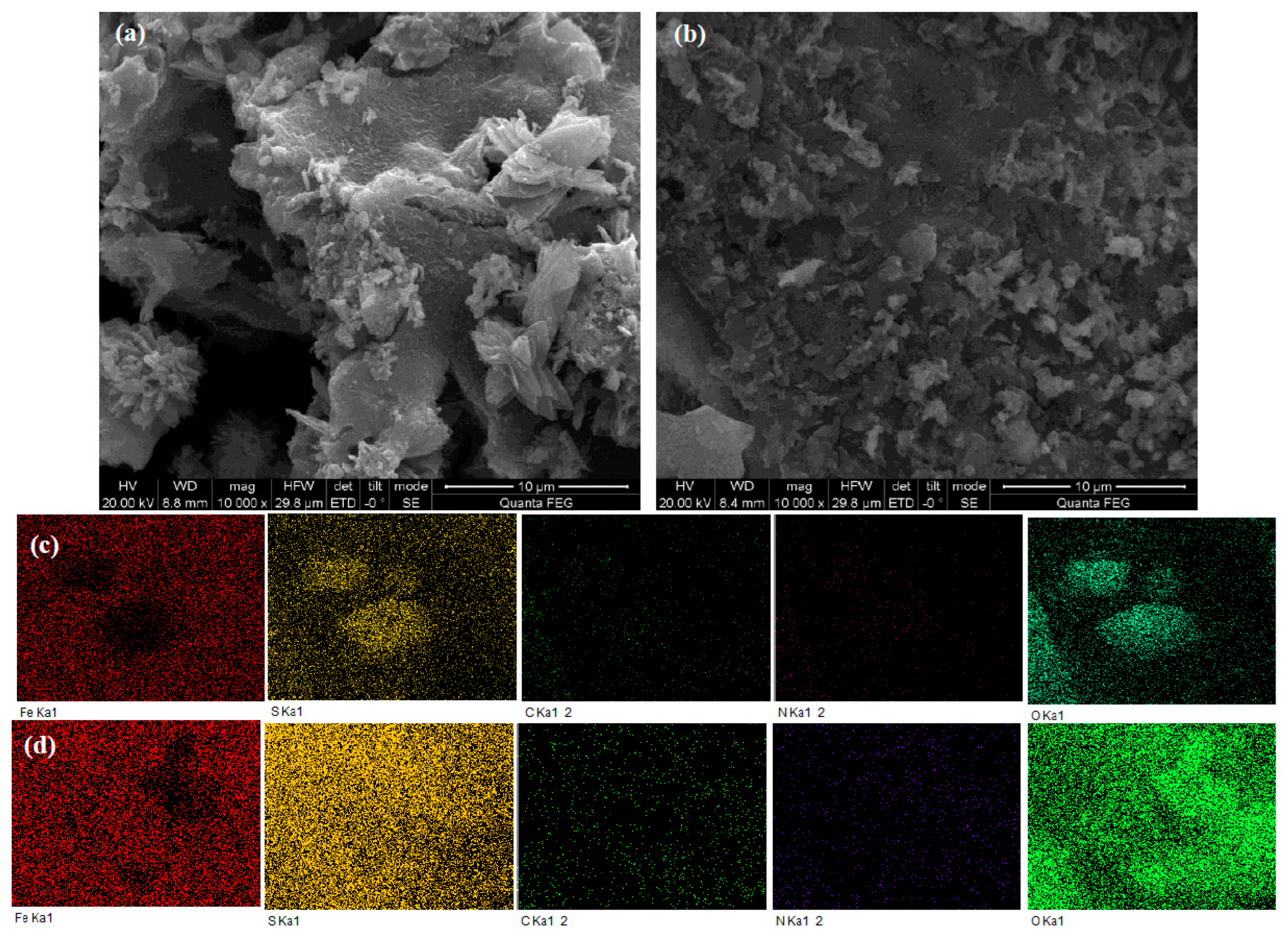
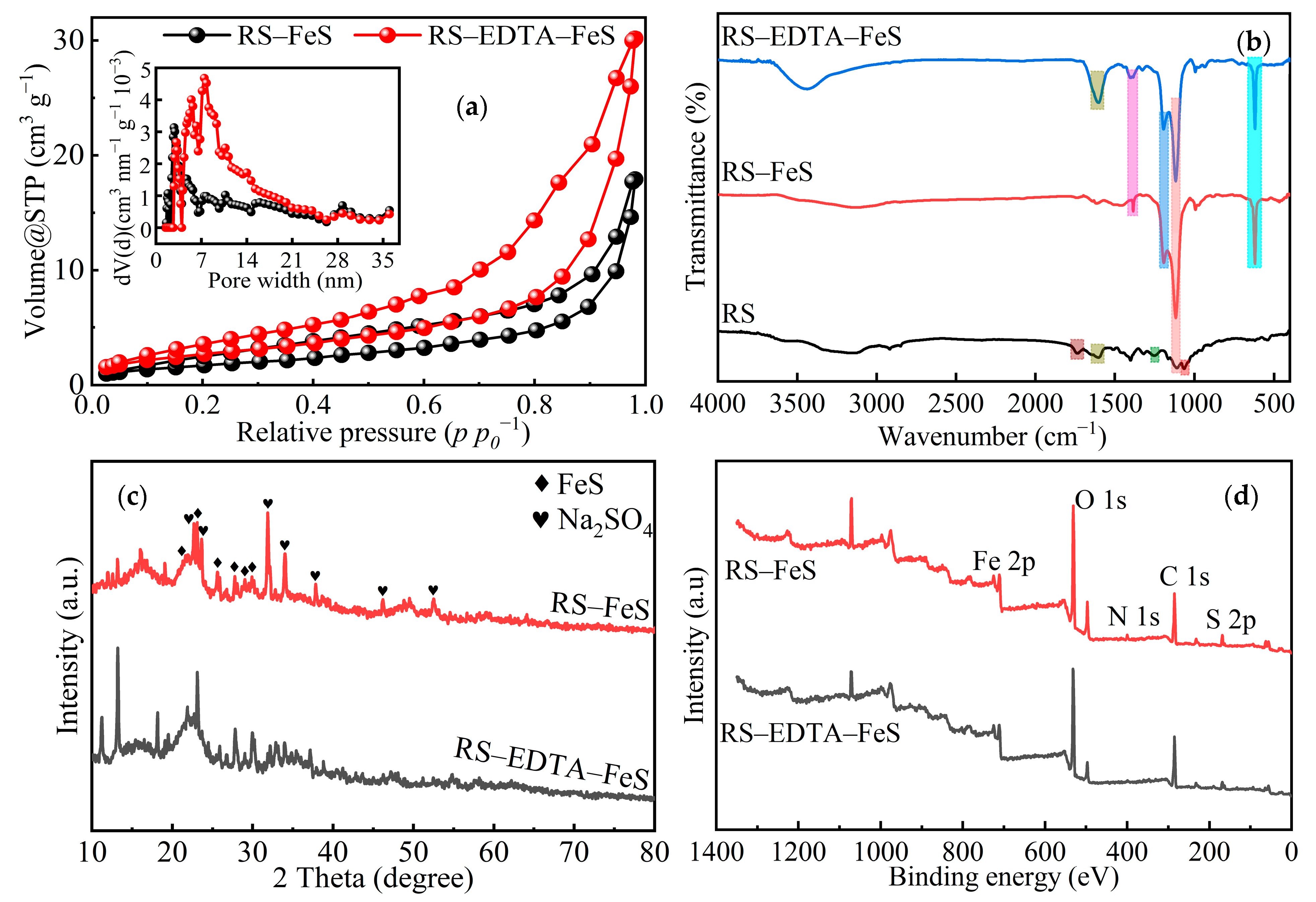
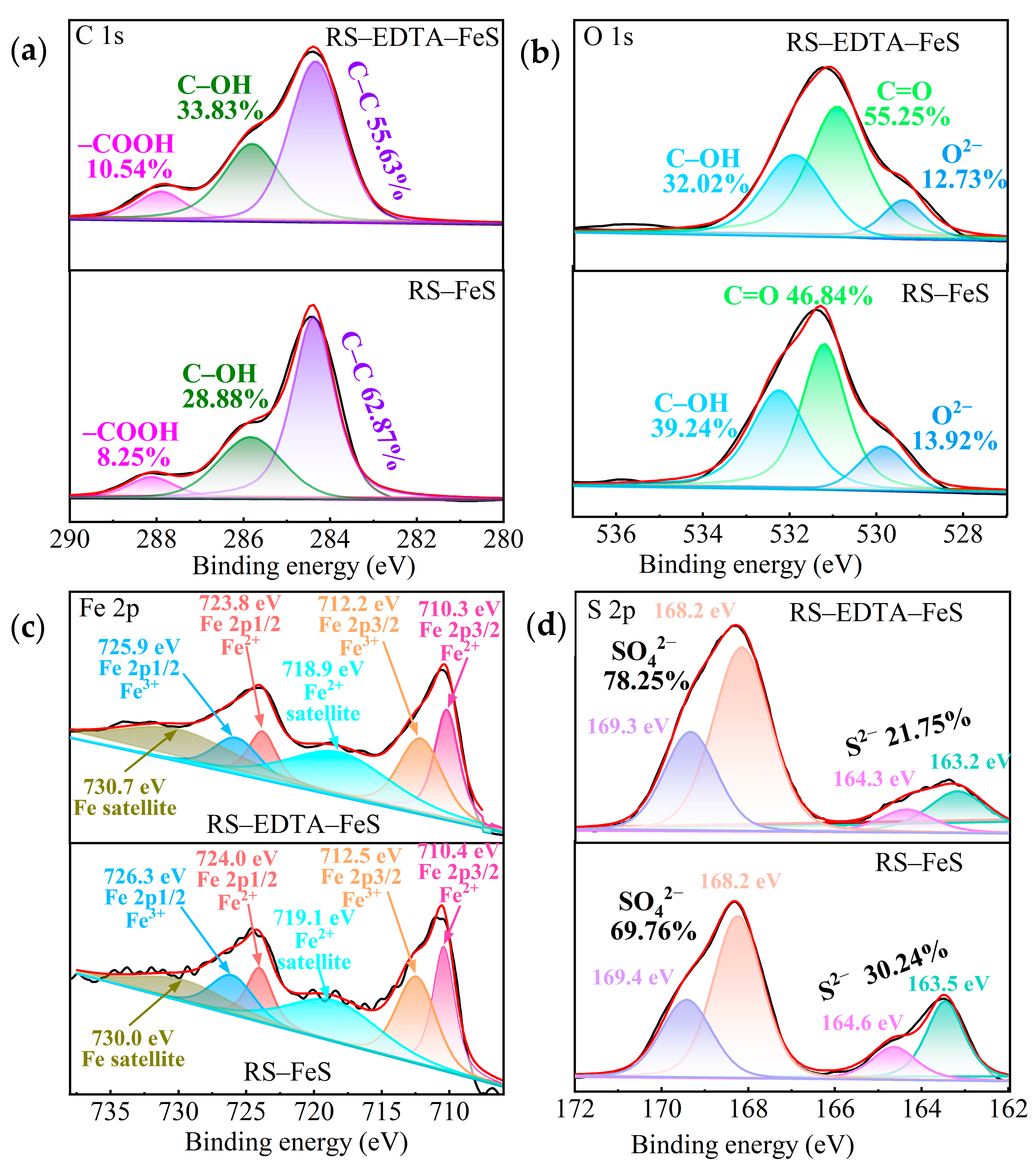



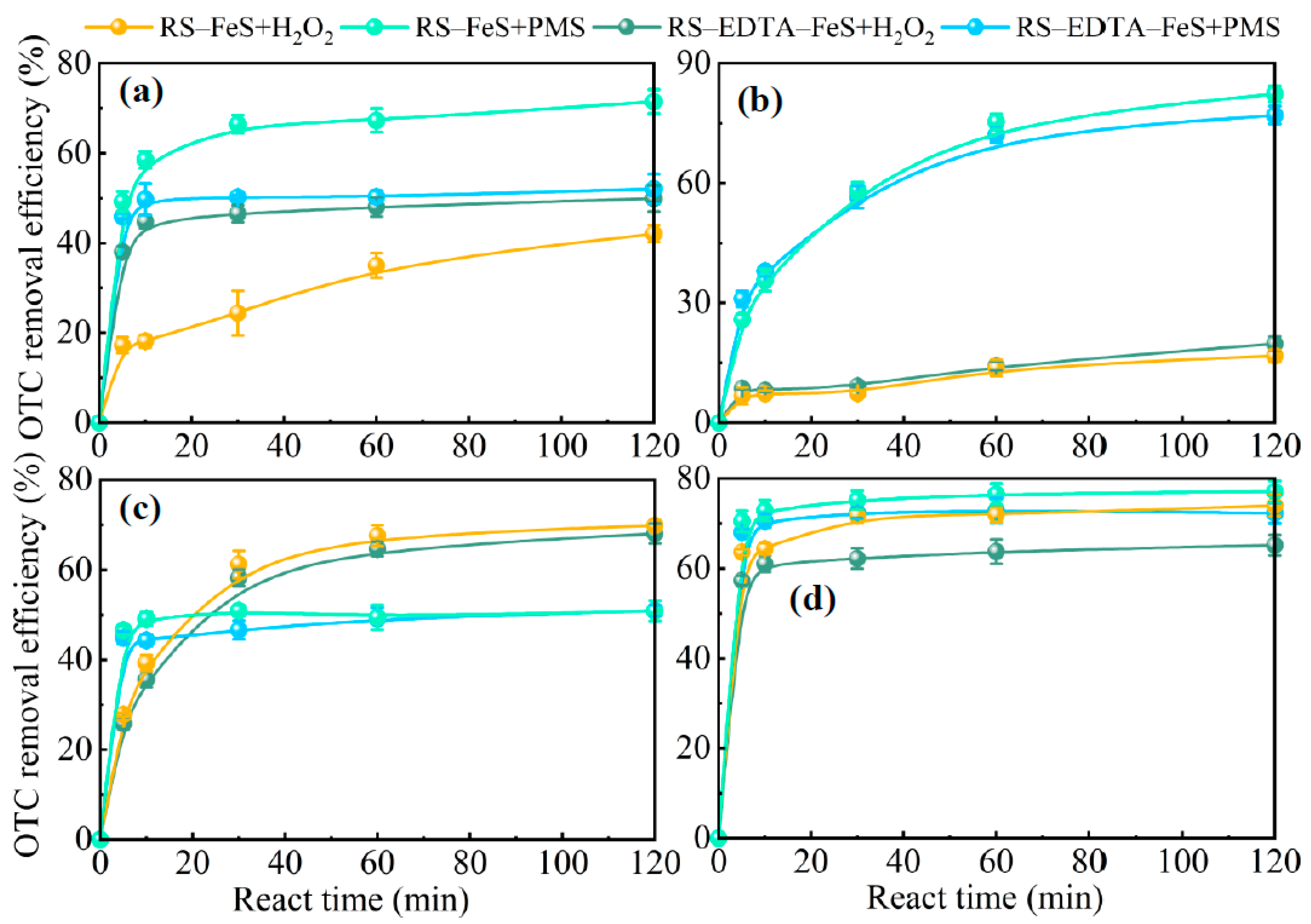
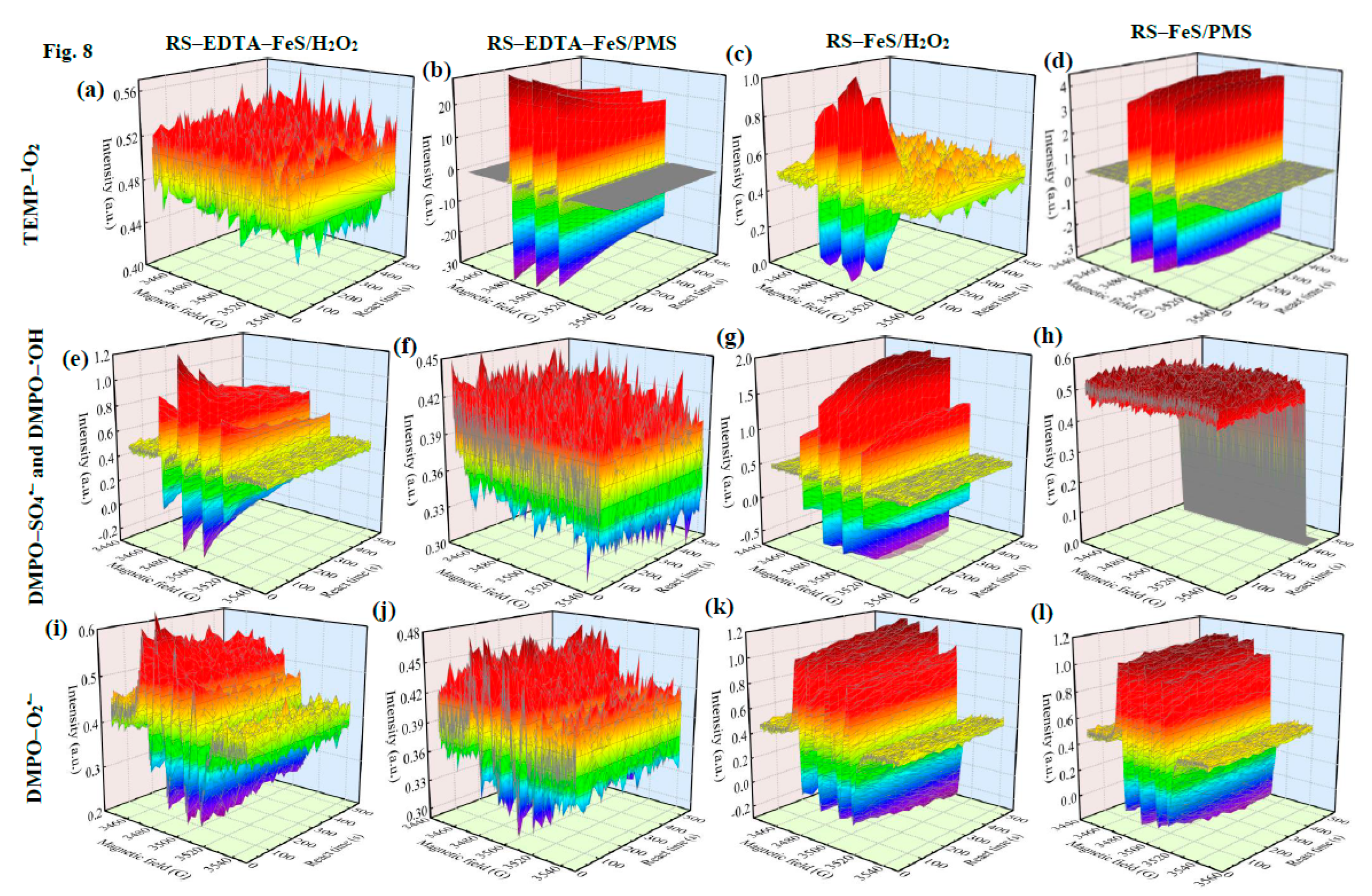
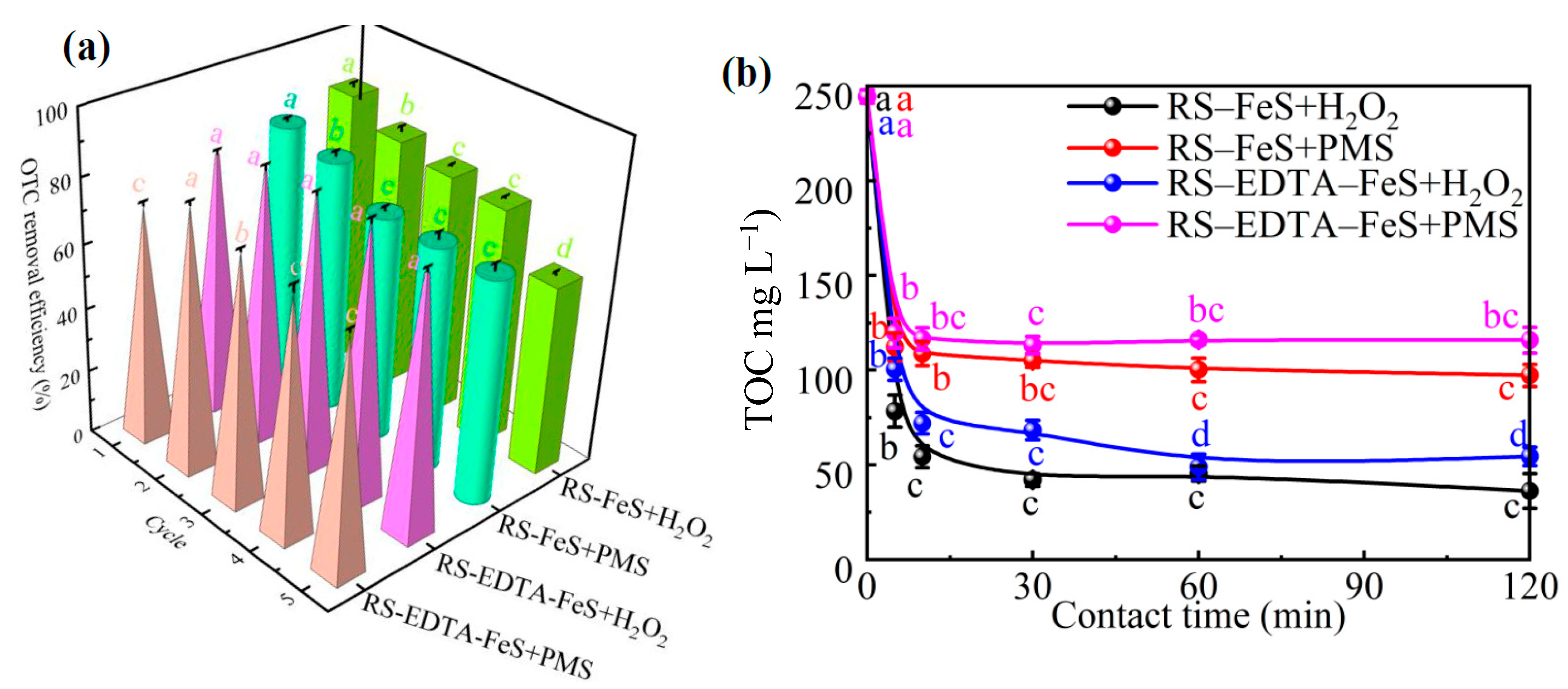
| Pollutants | Catalysts | Oxidant | Optimal Experiment Terms | Degradation Capacity | Ref. |
|---|---|---|---|---|---|
| Tetracycline hydrochloride | Magnetic rape straw biochar (MRSB) | Persulfate | Persulfate content 8.00 mM; MRSB dosage 1.00 g/L; Reaction temperature 25℃; Initial pH 5.68 | 99.00% | [19] |
| Reactive black 5 | Straw-iron composite material (ST@Fe) | Persulfate | Initial concentration 20.00 mM; Contact time 100.00 min; ST@Fe dosage 0.50 g/L | >94.80% | [20] |
| Acid Red 1 | Iron-loaded rice husk biochar | H2O2 | Initial concentration 50.00 mg/L; H2O2 concentration 16.00 mM; pH 3.00 | 98.00% | [21] |
| Tetracycline | Bagasse biochar modified with cobalt-iron | Peroxymonosulfate | Initial concentration 20.00 mg/L; Catalyst dose 0.30 g; Peroxymonosulfate concentration 0.40 g/L; Contact time 30.00 min; pH 5.00 | 96.70% | [22] |
| Sulfamethoxazole | Coconut shell biochar/C3N4 doped with magnetic oxygen | Peroxymonosulfate | Initial concentration 0.04 mM; Peroxymonosulfate concentration 1.60 mM; Catalyst does 0.40 g/L; pH 3.00 | 99.50% | [23] |
| Tetracycline | Cobalt and iron coloaded pomelo peel biochar | Peroxymonosulfate | Initial concentration 50.00 mg/L; Peroxymonosulfate concentration 1.00 g/L; Catalyst dose 0.10 g/L; pH 3.00 | 99.50% | [24] |
| Sunset Yellow | Fe-embedded waste coffee biochar | H2O2 | Initial concentration 10.00 mg/L; H2O2 concentration 5.00 mM; Catalyst dose 0.40 g/L; pH 3.00 | 93.00% | [25] |
| Phenol | Citrus peels biochar | Peroxymonosulfate | Catalyst dose 0.20 g/L; Peroxymonosulfate dosage 3.20 mM; Reaction time 60.00 min | 100% | [26] |
| Tetracycline | NaOH-modified Platanus orientalis Linn branches biochar | Peroxymonosulfate | Initial tetracycline concentration 0.02 g/L; Catalyst dose 0.50 g/L; Peroxymonosulfate dosage 0.50 mM; pH 4.79 | 97.90% | [27] |
| Oxytetracycline | Co3O4-corn straw hierarchical porous nanosheets | Peroxymonosulfate | Initial oxytetracycline concentration 40.00 μM; Peroxymonosulfate concentration 0.50 mM; Catalyst dose 0.20 g/L; pH 5.00; Reaction temperature 20 °C | 100.00% | [28] |
Disclaimer/Publisher’s Note: The statements, opinions and data contained in all publications are solely those of the individual author(s) and contributor(s) and not of MDPI and/or the editor(s). MDPI and/or the editor(s) disclaim responsibility for any injury to people or property resulting from any ideas, methods, instructions or products referred to in the content. |
© 2023 by the authors. Licensee MDPI, Basel, Switzerland. This article is an open access article distributed under the terms and conditions of the Creative Commons Attribution (CC BY) license (https://creativecommons.org/licenses/by/4.0/).
Share and Cite
Wang, G.; Yang, Y.; Xu, X.; Zhang, S.; Yang, Z.; Cheng, Z.; Xian, J.; Li, T.; Pu, Y.; Zhou, W.; et al. Rape Straw Supported FeS Nanoparticles with Encapsulated Structure as Peroxymonosulfate and Hydrogen Peroxide Activators for Enhanced Oxytetracycline Degradation. Molecules 2023, 28, 2771. https://doi.org/10.3390/molecules28062771
Wang G, Yang Y, Xu X, Zhang S, Yang Z, Cheng Z, Xian J, Li T, Pu Y, Zhou W, et al. Rape Straw Supported FeS Nanoparticles with Encapsulated Structure as Peroxymonosulfate and Hydrogen Peroxide Activators for Enhanced Oxytetracycline Degradation. Molecules. 2023; 28(6):2771. https://doi.org/10.3390/molecules28062771
Chicago/Turabian StyleWang, Guiyin, Yan Yang, Xiaoxun Xu, Shirong Zhang, Zhanbiao Yang, Zhang Cheng, Junren Xian, Ting Li, Yulin Pu, Wei Zhou, and et al. 2023. "Rape Straw Supported FeS Nanoparticles with Encapsulated Structure as Peroxymonosulfate and Hydrogen Peroxide Activators for Enhanced Oxytetracycline Degradation" Molecules 28, no. 6: 2771. https://doi.org/10.3390/molecules28062771
APA StyleWang, G., Yang, Y., Xu, X., Zhang, S., Yang, Z., Cheng, Z., Xian, J., Li, T., Pu, Y., Zhou, W., Xiang, G., & Pu, Z. (2023). Rape Straw Supported FeS Nanoparticles with Encapsulated Structure as Peroxymonosulfate and Hydrogen Peroxide Activators for Enhanced Oxytetracycline Degradation. Molecules, 28(6), 2771. https://doi.org/10.3390/molecules28062771








